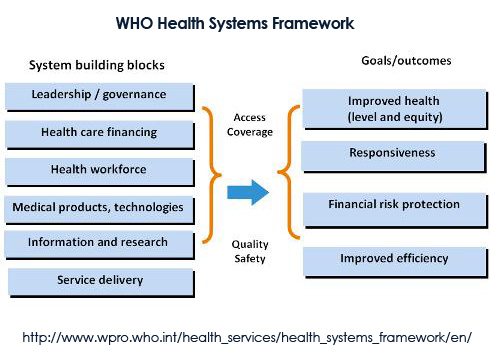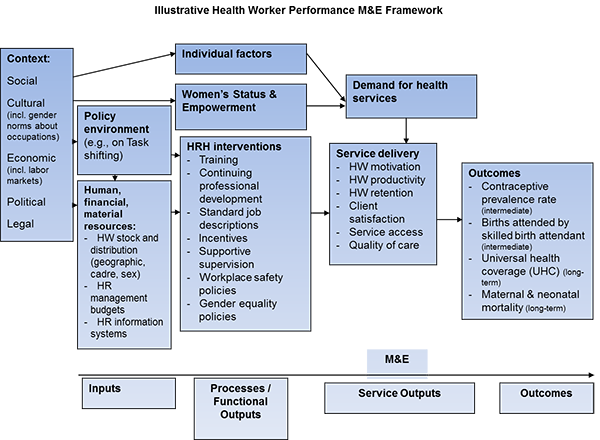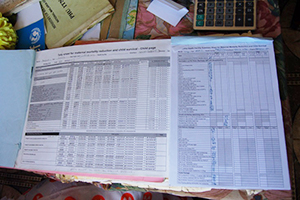
How CapacityPlus Is Helping Countries Improve Monitoring and Evaluation of Health Workforce Activities
This post was originally published on the Global Health Workforce Alliance Members’ Platform. We encourage you to join and contribute to discussions like this one.
In the field of human resources for health (HRH), access to reliable data and information is vital to make well-informed decisions. Dr. Eddie Mukooyo, assistant commissioner of health services in Uganda, expresses that need as well as the challenges he is facing to access reliable information.
Now, how do you make sure you set up appropriate systems and obtain the necessary data to get such reliable information?  This is what the USAID- and PEPFAR-funded CapacityPlus project set out to do. Realizing that of the WHO’s six building blocks of health systems the Health Workforce component has until recently received less attention, the project has been developing ways to track and measure progress and results in HRH through monitoring and evaluation (M&E) frameworks, tools, and indicators.
This is what the USAID- and PEPFAR-funded CapacityPlus project set out to do. Realizing that of the WHO’s six building blocks of health systems the Health Workforce component has until recently received less attention, the project has been developing ways to track and measure progress and results in HRH through monitoring and evaluation (M&E) frameworks, tools, and indicators.
The focus of this work has been on developing tools and improving measurement in HRH despite a lack of robust health workforce data in many countries. The work has included producing an eLearning course, guidelines, and indicators for HRH M&E, developing national HRH M&E capacity, identifying standard indicators to monitor HRH variables, and developing ways to track country-level efforts and progress.
For example, the project developed an HRH Indicator Compendium and an M&E of HRH eLearning course, and is finalizing guidelines for developing national M&E plans for HRH.
- The HRH Indicator Compendium provides a summary of standardized indicators for HRH in the areas of global leadership; health workforce policy, planning, and management; health workforce development; and health workforce performance support. Stakeholders can use this compendium to identify indicators to monitor the HRH situation in their countries. Since its launch in 2011, the HRH Indicator Compendium website has been visited 12,749 times—nearly 400 times per month) and the PDF has been downloaded 2,115 times.
- The free eLearning course, An Introduction to Monitoring and Evaluation of HRH, is hosted on the largest online HRH library in the world, the HRH Global Resource Center. It provides an introduction and informs course users of tools and resources to help develop M&E systems and plans for HRH. CapacityPlus adapted the course and presented it in Ghana and Uganda to assist stakeholders to develop national HRH plans that included a strong M&E component. These countries also used the Indicator Compendium as a primary reference document through which participants identified appropriate indicators for their national HRH plans. In the first four months after the launch of the eLearning course, the number of users grew more than 100 times. It continues to grow by about 20 users per month. Users come from 110 countries, and an average of 11% have completed the course and obtained a certificate.
- The guidelines will provide users with an orientation to M&E frameworks into which the different indicators can fit. Below is an illustrative health worker performance and enabling environment M&E framework. As can be seen, the framework details inputs (e.g., HR information systems), processes (e.g., continuous professional development, supportive supervision), outputs (e.g., health worker productivity), and outcomes (e.g., births attended by a skilled attendant) in relation to human resources for health. The guidelines also lay out sound M&E principles such as key characteristics of indicators and include references to a variety of frameworks, indicators, and M&E plans.

Together, the M&E guidelines, Indicator Compendium, and eLearning course build capacity in conceptualizing M&E frameworks and the measurement of HRH program inputs, outputs, and outcomes, while recognizing the challenges that countries and programs face in obtaining quality data necessary for generating and reporting on HRH indicators and metrics.
A final piece of work in CapacityPlus’s efforts to build capacity in M&E of HRH is the development of an HRH Effort Index (modeled after the Family Planning Effort Index), using the HRH Action Framework as a conceptual guide. The index is made up of 75 questions/items, each one scored through a 1 to 10 rating scale and grouped into eight technical dimensions:  1. Leadership and Advocacy
1. Leadership and Advocacy
2. Policy and Governance
3. Finance
4. Education and Training
5. Distribution, Deployment, Recruitment, and Retention
6. Human Resources Management
7. Monitoring and Evaluation
8. Data and Information Systems.
The tool will allow implementers to measure country-level HRH efforts in order to identify strengths and weaknesses, monitor progress over time, and compare countries in their efforts towards improving HRH systems.
Key topics for discussion
1. What do you feel are important challenges to country efforts to improve the measurement of HRH? For example, skill gaps, little interest of country and/or donors, few references and examples to help users?
2. From frameworks to indicators, methods, instruments and funding, what seems to be most needed in relation to M&E of HRH?
3. Which area(s) would you like to see more progress in the measurement of HRH? For example: Leadership? Preservice education or in-service training? Recruitment, promotion, and retention? Information systems? Performance support? Gender and safety in the workplace?
Thank you!
Help CapacityPlus spread the word about strengthening the health workforce. Follow us on Twitter and like us on Facebook.
Related items:
Photo by Alfredo Fort (Maternal, Newborn, and Child Health logbooks from a facility in Sierra Leone)


